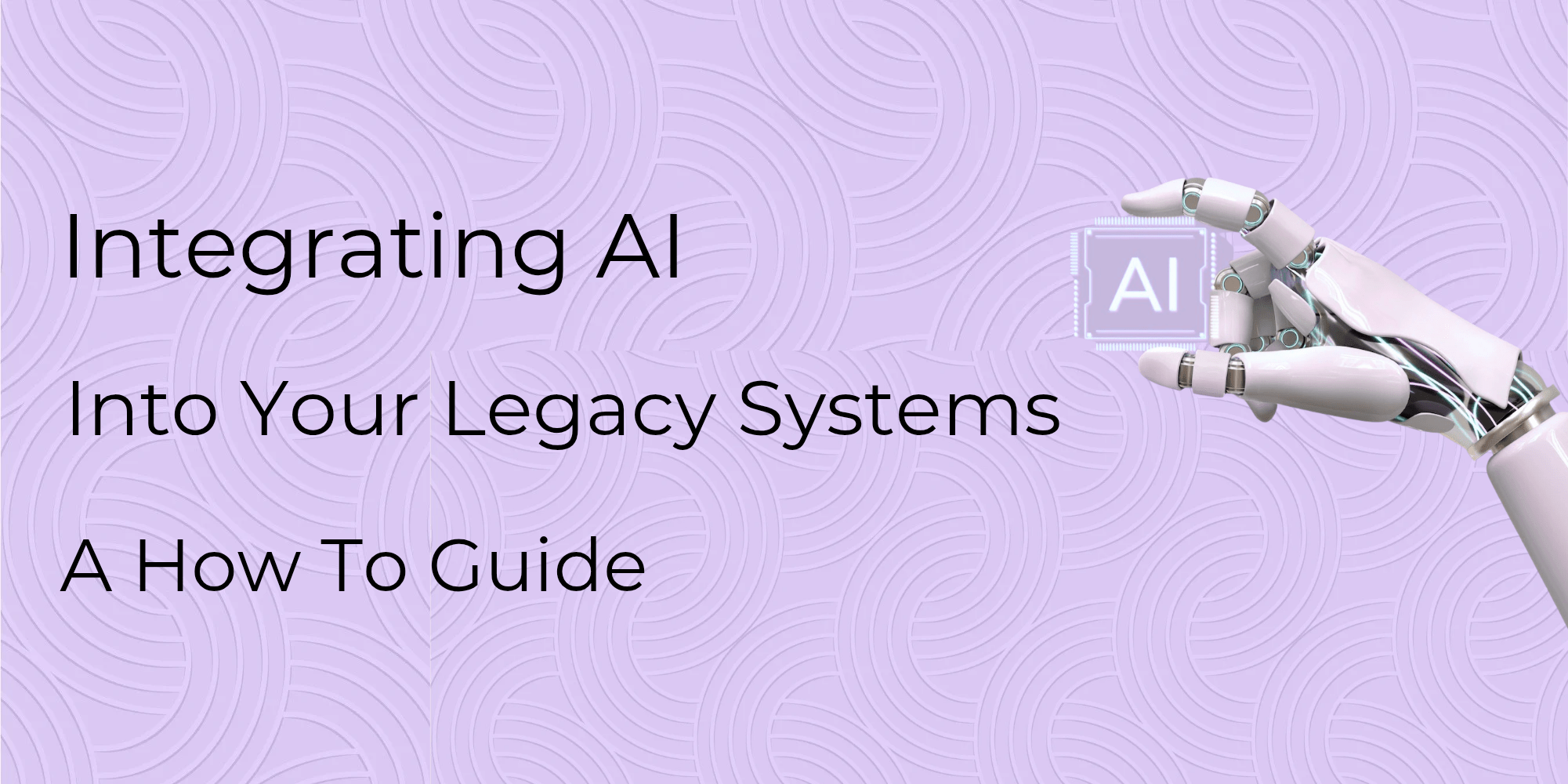In today’s fast-paced digital world, artificial intelligence (AI) is no longer a futuristic concept — it’s a competitive necessity. From automating repetitive tasks to delivering deep insights through data analytics, AI has revolutionized how businesses operate. However, for companies still running on legacy systems, integrating AI can seem daunting.
Legacy systems, sometimes the foundation of many long-standing companies, were developed during an earlier time — well before AI, cloud computing, or even the internet was mainstream. Legacy systems tend to be mission-critical, hard to replace, and thoroughly ingrained in an organization’s workflow. But with proper planning, incorporating AI into legacy systems is not only achievable — it can dramatically add years to their lifespan and add value.
In this complete guide, we’re going to look at how you can implement AI in your legacy systems, the challenges that you may encounter, and how best to overcome them.
●Why Integrate AI with Legacy Systems?
First things first: let’s get a good reason for why you would integrate AI into legacy systems before leaping into the “how:”
- Extended System Lifespan: AI can bring new life to old systems, keeping them from needing pricey upgrades sooner.
- Enhanced Decision-Making: AI will be able to examine huge datasets created by legacy systems to reveal patterns and enable data-driven decision-making.
- Automation: AI-driven bots and scripts can automate time-consuming processes that legacy systems frequently necessitate.
- Better Customer Experience: AI can bring in chatbots, recommendation engines, and predictive support without re-piping existing systems.
● Step-by-Step Guide to Integrating AI into Legacy Systems
Step 1: Evaluate Your Legacy Systems.
Begin with a detailed audit of your existing IT environment:
- What languages, platforms, and databases are employed?
- Do APIs exist or can be implemented?
- What data are stored, and in what format?
- How mission-critical is each application?
You require a clear map of your existing infrastructure in order to know which systems are good candidates for AI integration and which ones may require modernization or replacement
.
Step 2: Set Your AI Goals
AI is not a one-size-fits-all tool. Set precise goals according to your business requirements. Typical use cases are: - Predictive maintenance
- Fraud detection
- Customer churn prediction
- Natural language processing (NLP) for customer support
- Supply chain optimization
After you decide on the problem you are attempting to solve, you can then determine more clearly what types of AI tools and models you will require.
Step 3: Determine Data Readiness
Data is the fuel for any AI engine. Legacy systems often store data in silos or inconsistent formats. You’ll need to:
- Clean, label, and organize data
- Break down silos to enable integration
- Ensure data privacy and compliance (GDPR, HIPAA, etc.)
- Use data lakes or warehouses to centralize data if needed
If your data isn’t AI-ready, your models won’t deliver value — regardless of how sophisticated they are.
Step 4: Select the Proper AI Tools and Frameworks
You do not have to start from scratch. Consider the following:
- Open-source platforms such as TensorFlow, PyTorch, or Scikit-learn
- Cloud-based AI platforms such as AWS SageMaker, Google AI Platform, or Azure Machine Learning
- Low-code AI platforms such as DataRobot or H2O.ai for rapid deployment
In selecting a platform, take note of compatibility with your existing systems and integration abilities such as APIs, connectors, or SDKs.
Step 5: Create APIs and Middleware
Legacy systems tend to have no contemporary integration mechanisms. That’s where middleware and APIs step in.
- Utilize middleware to translate between AI models and legacy applications
- Create RESTful APIs to publish data or business logic from legacy systems
- Look into API gateways for handling, protecting, and scaling access
If direct integration is not feasible, you can even employ RPA (Robotic Process Automation) tools to communicate with legacy UIs without modifying the backend.
Step 6: Pilot a Project
Test your AI solution with a pilot before going all-in:
- Select a low-risk, high-impact business case
- Leverage actual production data
- Track ROI and system performance
- Engage key stakeholders early
A successful pilot justifies continued investment, reveals technical problems, and provides your team with hands-on experience.
Step 7: Monitor, Maintain, and Scale
AI is not “set-it-and-forget-it.” After your model goes live:
- Regularly monitor performance and accuracy
- Re-train models on fresh data
- Maintain ongoing compliance with data regulations
- Scale the solution to other business units or systems
Also, establish governance around AI use to guarantee transparency and ethical decision-making.
● Typical Issues (And Solutions)
- Technical Incompatibility
Issue: Legacy systems might not be capable of supporting contemporary AI libraries, data types, or APIs.
Solution: Employ middleware, emulators, or encapsulate legacy systems with microservices. Isolation through containerization (e.g., Docker) can limit dependencies. - Data Quality Problems
Issue: Legacy systems tend to have incomplete, inconsistent, or unstructured data.
Solution: Spend money on data cleaning, transformation, and enrichment. Build master data management (MDM) solutions for better data quality over time. - Resistance to Change
Problem: Staff will resist the introduction of new technologies that interfere with established processes.
Solution: Emphasize change management. Give training, explain benefits clearly, and include staff in the process of change. - Security and Compliance Risks
Problem: AI poses new security risks, particularly when processing sensitive information.
Solution: Encrypt information, apply role-based access control (RBAC), perform frequent audits, and make AI systems conform to industry standards and legislation. - Cost and Complexity
Problem: AI integration initiatives are likely to be capital-intensive.
Solution: Pilot it only to begin, use cloud-based platforms to save money on up-front investments, and implement high-ROI scenarios first.
● Example: AI Integration in Banking
Most banks remain on COBOL-based mainframes. Replacing them in their entirety is risky and costly, so banks like JPMorgan Chase have pursued hybrid solutions:
- Middleware acts as an interface between COBOL platforms and Python-based AI models
- AI scans real-time suspicious transactions from analyzing patterns in historical datasets
- Natural Language Processing (NLP) powers chatbots to respond to customer inquiries, coupled with existing CRM databases
This methodology enables the bank to modernize incrementally without sacrificing stability or security.
● Top Practices for Effective AI-Legacy Integration
- ROI-centric, not technology-centric – Prioritize use cases that yield business value.
- Engage cross-functional teams – IT, data science, operations, and compliance must work together.
- Document all things – From data lineage to model decisioning, for transparency and future audits.
- Scale with ease – Design integrations that scale with your data and business growth.
- Keep human oversight – Leverage AI to augment, not replace, key decision-making.
● The Future of Legacy Systems in an AI World
It’s easy to look at legacy systems and see them as outdated, but with AI, they can become engines of power. AI brings new vitality to old platforms, making them intelligent, responsive, and cost-effective. The secret is strategic integration, not blanket replacement.
As industries as a whole embrace AI — from medicine to production to logistics — those that can best navigate the gap between new and old will be most likely to thrive in the long term.
Final Thoughts
Bringing AI into your existing systems is a difficult path, but one of monumental potential. It demands clear objectives, clean data, and deliberate planning — but the payoff is greater efficiency, deeper understanding, and operations ready for such time as it comes.
Whether starting from scratch or already dabbling in AI, the single most critical step is beginning with a solid, realistic plan. You don’t have to rip and replace your whole infrastructure. With the right methodology, AI and legacy applications can coexist — and even flourish — in harmony.


